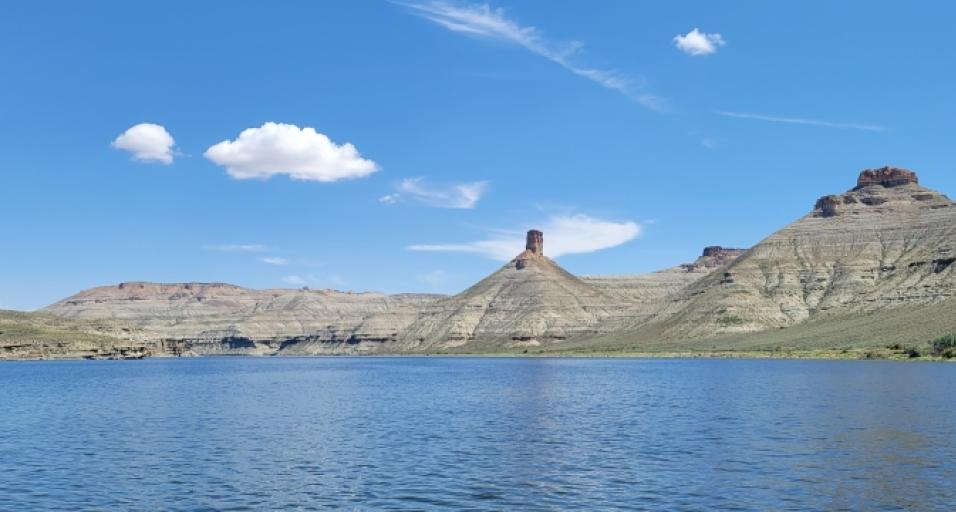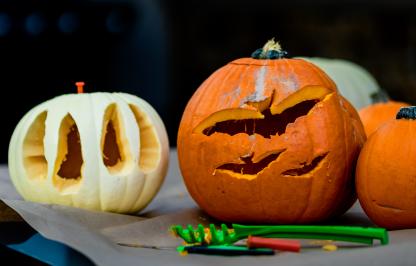Flaming Gorge Reservoir spans Wyoming and Utah, and the fishery is co-managed by the Wyoming Game and Fish Department and Utah Division of Wildlife Resources. The popular fishery attracts anglers in search of trophy kokanee salmon and lake trout, with anglers traveling from neighboring states to take advantage of the abundance of lake trout less than 25 inches. Recently kokanee salmon populations have not been as high as just a few years ago. The reduction in numbers is likely due to increasing numbers of small lake trout and recent reservoir drawdowns. Managing this resource is a responsibility that is not taken lightly. Some of the management actions taken to date are outlined below, along with possible options for future management.
Challenges facing fisheries managers:
The managing agencies have been working to mitigate challenges posed by the illegal introduction of burbot, and the population growth of lake trout, which are now at a surplus that negatively impacts sportfish populations. The main concerns are lake trout less than 25 inches and, recently, a large group of juvenile lake trout, less than 17 inches. Challenges associated with managing lake trout are well-documented across the West. Actions taken at other reservoirs help inform management at Flaming Gorge.
The negative impacts of small lake trout on kokanee salmon have been well-researched in Colorado’s Blue Mesa Reservoir. According to Colorado Parks and Wildlife literature, lake trout abundance in Blue Mesa Reservoir expanded from the 1990s through the late 2000s. Fisheries biologists observed predation by lake trout on salmon. After observing a 90% decline in kokanee abundance, in 2009, managers initiated fall netting to remove small lake trout in an effort to recover kokanee while still providing for a trophy lake trout fishery. Managers also encouraged anglers to keep all non-trophy lake trout they caught. Fall netting and angler harvest removed about 7,200 lake trout annually from 2009 through 2017. Removal efforts targeted Lake trout 32 inches and smaller.
Regulation changes to improve the fishery
Flaming Gorge Reservoir fisheries managers have been seeking to reduce the population of small lake trout by increasing the limit on lake trout less than 28 inches. Starting in 2006, the daily creel limit for lake trout was liberalized, from an aggregate daily limit of six trout and salmon to a separate daily limit of eight, only one over 28 inches. In 2019, the limit on lake trout was increased from 8 to 12 fish per day, only one over 28 inches and allowed anglers to keep two limits of lake trout in their possession after the first day —something that is not permitted for other sportfish in the region. Unlimited harvest of burbot initiated in 2008, reclassifying burbot in Area 4 as a nongame fish and reinstating the must-kill regulation in 2014 have helped reduce the burbot population and subsequently its impact on the other fisheries.
Derbies targeting problem populations of burbot and lake trout
In response to the abundance of lake trout less than 25 inches and concerns over their potential impact on the sport fisheries in Flaming Gorge, an educational outreach campaign to increase harvest was initiated in the early 2000s. As part of this campaign, personnel from WGFD and UDWR collaborated with several contest sponsors to establish categories that targeted small lake trout in recent years. Contest sponsors included Lucerne Marina, Buckboard Marina, Flaming Gorge Chamber of Commerce, and Ducks Unlimited. Anglers participating in these contests since 2017 have harvested just shy of 4000 lake trout less than 25 inches. In addition to removing a good number of small lake trout, the promotion of the contests helped inform the public of the abundance of small lake trout, their impact on other game fish and the need to harvest lake trout less than 25 inches.
Lake trout are not the only fish species negatively impacting other sportfish populations. Burbot were illegally introduced years ago, resulting in adverse effects on the numbers of smallmouth bass, kokanee and trout. In a concerted effort to reduce the burbot population, fisheries managers partnered with local businesses to host fishing derbies that targeted these invasive predators. Since their inception in 2010, burbot fishing contests, including the Burbot Bash and Burbot Classic, have removed over 56,000 burbot from the lake. Burbot trend netting data collected annually confirms that efforts are paying off. The netting data has been below the maximum objective of one burbot per hour across the reservoir for the past three years.
Stocking
Managers invest in the fishery through the annual stocking of fish. Nearly 70% of the kokanee raised in Wyoming are stocked into the reservoir. Kokanee were first stocked in 1964 to take advantage of abundant pelagic zooplankton and add diversity to the fishery. By 1988, kokanee had become an integral part of the fishery, serving as a forage fish for lake trout and a highly sought-after sportfish.
Annual kokanee stocking was initiated in 1991 with the goal of stocking between 1-1.5 million annually. Actual numbers stocked between 1991-2013 varied from about 79,000 to 1.9 million. Jones Hole National Fish Hatchery (JHNFH) started stocking 300,000 kokanee in 2006 at the request of Game and Fish. By the early 2010s, fisheries managers from Wyoming, Utah and Jones Hole agreed to a combined goal of annually stocking 1.65 million three-inch kokanee. From 2015-2022, the average annual number of kokanee stocked was 1.77 million.
Why stock a sportfish as forage? There are limits to how many healthy fish a lake or reservoir can support, even a reservoir as large as Flaming Gorge. The foundation of the food web is phytoplankton, which feeds the zooplankton, which feeds many of the fish in the reservoir but is especially important to kokanee. In the early years, much of the zooplankton was consumed by non-game fish, including Utah chubs and white suckers. This meant the reservoir could support fewer sportfish. Eventually, predators consumed the non-game fish populations, freeing up the zooplankton for sportfish. As the populations of the non-game fish declined, the lake trout transitioned to foraging on kokanee. Fisheries managers aimed to maximize the sportfish community by utilizing kokanee as forage for lake trout and as a renowned trophy kokanee fishery without sacrificing a portion of the zooplankton community on non-game fish. This strategy worked well from the early 1990s until about 2019. A combination of reservoir drawdowns and the abundance of small lake trout took a toll on the juvenile trout and kokanee populations starting around 2020-21.
Recently completed and ongoing research
Multiple research projects have recently been completed, and others are ongoing to understand the fishery better and inform management decisions.
In 2018, a study sought to determine if kokanee caught by Flaming Gorge anglers were stocked or the result of natural reproduction. The research completed in 2021 by Aaron Black from the University of Idaho found that 20 to 50 percent of the fish caught by anglers had been stocked. This highlighted the importance of continued stocking to maintain the fishery for anglers. This study also determined that a large proportion of the population is driven by natural spawning. When natural spawning success is low, recruitment to the angler will likely be lower.
Additional research was pursued regarding lake trout growth and feeding ecology. Research completed by Chance Roberts from the University of Wyoming in 2022 determined that lake trout 14-22 inches may, at times, have 25 percent of their diet consist of kokanee... Although lake trout under 18 inches primarily consume zooplankton, their large population and opportunistic nature of also preying on kokanee can significantly impact the kokanee population.
For example, suppose the population of small lake trout is around 130,000, each consuming just ten kokanee yearly. That equates to 1.3 million kokanee lost to predation and unavailable to anglers and trophy lake trout.
Knowing the diet of small lake trout is helpful. Still, managers do not have a complete picture to inform management decisions without quantifying the numbers of lake trout in the reservoir. Accomplishing this requires a population estimate. Many anglers will recall articles from last fall letting anglers know about all the tagged lake trout they might catch and that a portion of them are worth $50. The return achieved on these tags via anglers and netting will help estimate the number of lake trout in the reservoir. Coupling the population estimate with data from the food web ecology study will show how lake trout impact other fisheries.
In January 2023, managers initiated a creel survey to engage with anglers, document their fishing efforts, and determine what portion of the lake trout population anglers are harvesting. This information, along with the population estimate and other research results, will be used to assess target harvest rates for lake trout to achieve a healthy lake trout population that is in balance with a robust trout and salmon fishery. If results show that angler harvest alone will not achieve the desired balance, another avenue, such as commercial harvest, will need to be considered along with other options.
Future
Upcoming management proposals may include removing the creel limit on small lake trout, similar to the current burbot regulation. Netting or potential commercial fishing operations targeting the abundant population of small lake trout could be considered to reduce predation on trout and kokanee. The goal is to reduce the abundance of small lake trout while maintaining the existing trophy lake trout fishery. As the numbers of small lake trout are reduced, the survival of stocked and wild sportfish and recruitment to the angler will improve.
“We appreciate that anglers' are concerned about the Flaming Gorge fishery. Most Game and Fish employees are avid anglers, and many of us spend hundreds of hours a year pursuing the variety of game fish in the reservoir. We hope you will join us year-round in the pursuit of small lake trout not only for the table but in an effort to do our part to help manage their numbers for the benefit of the whole fishery.” Said Robb Keith, Green River Fisheries Supervisor for Wyoming Game and Fish.
For tips on how to catch small lake trout, visit the Flaming Gorge Management Page.
Managing the fishery at Flaming Gorge Reservoir is a collaborative effort



